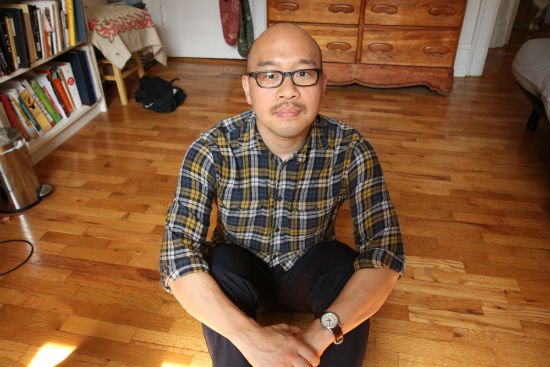
Eugene Lim’s novels tread the line between the hypnotically familiar and the surreptitiously terrifying. His latest novel, The Strangers, follows multiple sets of twins through landscapes alternately recognizable and surreal. Underground film scenes, stand-up comedy, shipborne communities, and totalitarian states all appear, and yet the entire work remains even-tempered and cohesive. As the publisher of Ellipsis Press, Lim has ushered books from the likes of Norman Lock and Eugene Marten into the world. As an admirer of both The Strangers and his earlier novel Fog & Car, I was curious to learn more about Lim’s process, and so we checked in earlier this month via email.
Early in The Strangers, there’s a long meditation on stand-up comedy. What prompted this as a starting point for the novel?
Comedians are sometimes called stand-up artists. I always liked this idea of the job just being a person standing up and talking. Especially I like that this rather personal, almost quaint occupation survives — and in fact thrives (in comparison to the personal, almost quaint occupation of the novelist) in an era of entertainment defined as visual spectacle. In addition, and maybe more importantly, this novel is structured as a series of monologues. A monologist is a particular type of character, trapped by the sound of their own voice and in the deep gravity well of their own point of view. One goal of the book was to show a long series of these moated, solipsistic monologues (which we sometimes trade with one another and then dignify the exchange with the term conversation) as a rendering of everyone’s dazzling alienation. I thought a “stand-up artist” might be a good one to start off such a series.
Your new novel features everything from shipboard life to underground filmmaking circles to life in a totalitarian state. Where did all of these disparate elements come from, and how did you start to bring them together?
When I first moved to New York, in the late 90s, one of the highlights of my week was reading J. Hoberman’s film criticism in The Village Voice. He’s terrific, a giant, and much of the cinema ideas in the book owe a debt to him. The totalitarian state in the novel probably comes equally from reading about the CIA’s so-called “enhanced interrogation techniques” and Abu Ghraib and the incredible kidnapping and escape story of Eun-hee Choi and Sang-ok Shin. I’ve never been on a cruise ship. I’m not sure where all the elements in the book came from, but I can say that I wanted the sections to be complete and whole in tone and style yet disparate from one another. And then the odd sections are placed next to each other with just a few, vital threads holding the pieces in place.
Both The Strangers and Fog & Car make use of characters with distinctive, stylized names. What attracts you to this approach, and how do you come up with the right name for a particular character?
I’m not sure. In Fog & Car the names refer to a perhaps false dichotomy of styles, and the names of characters given in the chapter titles actually change or evolve, indicating a progression from abstractions to more traditional characterizations. A “Ms. Car” becomes “Sarah Car” and then becomes just “Sarah”. The names in The Strangers are less schematically purposed. “Oona” was the first name of the daughter of Eugene O’Neill, a playwright a family story says I was named after. “Noona” also means older sister in Korean. Little factoids coalescing into influence… The idea of our identities in “real life” may seem much more solid compared to ideas of characters in fiction, but that seems less and less true once one starts writing narratives. Tobias sent me this email. Eugene is typing now. All seems clear at first. But when writing a story one realizes how artificial the concept of character can be. You can do a find-and-replace and change occupation, gender, race. Slightly more editing work and you change sense of humor, affect. And there are Twilight Zone implications once you see that these lessons extend from fiction characters to our understandings of so-thought more stable notions of identity. Is the Tobias emailing me the same that I spoke to? Would he be very different if his name were Eugene? Who actually received his email? Paralysis, nausea, the beginnings of religious ritual or game play.
At BookThugNation, you spoke of the novel having more realistic and more surreal plotlines — how do you go about finding the appropriate balance between the two?
Continuity is a (useful) illusion. And I think we experience it something just like that. It’s an illusion we allow ourselves to be convinced by. However, semi-secretly from ourselves, parenthetically, we know it’s a utility, not reality itself (or if so, then only one aspect of it). I wanted the book to operate somewhat like that as well. Within a section I aimed for it to have its own physics and sense of unity and be an integrated whole. However each would then be placed next to another equally whole narrative. Could they survive the juxtaposition? Lines of poetry can. Elements of a collage can. Our senses of self do.
There’s a blurb from Harry Mathews on the back cover of The Strangers, and one of the other blurbs invokes George Perec. Was the Oulipo an influence on this book?
Not directly. I love both of those writers, but this wasn’t a novel created by Oulipian-type constraints. Unless it was unconsciously the beautiful “Canada Dry” constraint I recently learned about (from this interview with the novelist Jeremy M. Davies), which is to write “something that reads as though it was written under a constraint, but was not.”
Follow Vol. 1 Brooklyn on Twitter, Facebook, Google +, our Tumblr, and sign up for our mailing list.
